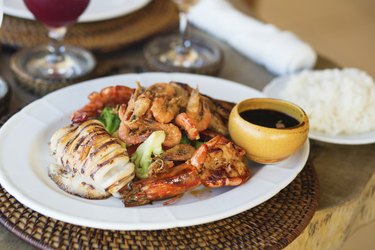
Diet is an integral part of managing your diabetes, but you may feel you're limited in what you can eat. While there are some less than healthy options in the Filipino diet, such as the ice cream-like dessert halo-halo, as long as you know the basics for healthy eating, you can enjoy a variety of Filipino foods and still manage blood sugar. Diabetes diet education is especially important for people in the Filipino community given that diabetes is so prevalent, according to a 2001 report published in "Diabetes Care."
Filipino Diet Basics
Video of the Day
Rice is the mainstay of the Filipino diet, and rice flour is used to make noodles and bread. Filipinos also enjoy noodles made from mung beans or wheat, which are usually mixed with meat and flavorings. Soups and stews made with meat and vegetables are also consumed and often served as a main entree or side dish. Compared to other Asian diets, the Filipino diet is higher in fat, saturated fat and cholesterol, according to Adoption Nutrition, which is important to know given the increased risk of heart disease for people with diabetes. In the U.S., Filipinos also consume a lot of sugar and use high amounts of cooking oil.
Video of the Day
Carbs and Blood Sugar
People with diabetes either do not make enough insulin or their body's cannot properly use the insulin that is made. Insulin is a hormone that gets the sugar from your bloodstream into your cells. Without insulin, the sugar stays in your blood, which ultimately damages your body and organs. Carbohydrates, found in foods such as bread, rice, fruit and milk, are broken down into sugar. Controlling the amount of carbs you eat throughout the day can help you gain control of your blood sugar.
Carbs in the Filipino Diet
Knowing the sources of carbs in your diet can help you understand how to better manage your blood sugar. In addition to rice and bread, typical carb foods in the Filipino diet include starchy vegetables such as cassava, sweet potatoes and peas. Fruits such as apples, bananas, oranges and durian also contain carbs, as do yogurt and milk. Mixed foods, such as lumpia and chicken long rice, also contain carbs and need to be eaten in moderation.
Sample Meal Plan
Your doctor or dietitian can help you determine the amount of carbs you need to eat at each meal. In general, limit carbs to 30 to 60 grams per meal, where 1/3 cup of rice, one slice of bread, 1 cup of milk or one-half mango are equal to 15 grams of carbs. A 45-gram, carb-controlled, Filipino-inspired breakfast might include 2/3 cup brown rice -- make at least half your grain choices whole grain for better health --, a boiled egg and a small orange. For lunch, you might enjoy 1 cup of pinkabet made with vegetables and fish, half a mango and 3 ounces of low-fat fruited yogurt for 45 grams of carbs. A healthy, 45-gram carbohydrate Filipino dinner for diabetes might include chicken adobo with 1 cup of brown rice and a garden salad with oil and vinegar.
- American Diabetes Association: What Can I Eat?
- Business World Weekender: Diabetes and the Filipino Diet
- San Jose State University: Carbohydrate Counting With Filipino Foods
- Adopt Nutrition: Philippines
- International Diabetes Federation: About Diabetes
- Hawaii Dietetic Association: 1,800-Calorie Sample Menu, Filipino Men
- Diabetes Care: Prevalence and Determinants of Type 2 Diabetes Among Filipino-Americans in the Houston, Texas Metropolitan Statistical Area
- International Federation of Diabetes: Complications